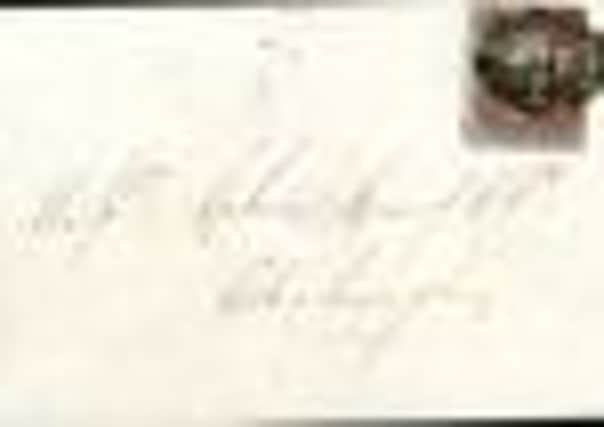Rare stamp to fetch £4000


Auctioneers have described the Victorian relic as “superb” owing simply to the rarity of the stamp stuck in its top right-hand corner.
As one of the first ever perforated postage stamps – a one penny red brown – it is expected to have collectors whipped into a frenzy when it goes under the hammer, especially as it is also thought to be the first of its kind to have been sent to the Capital.
Advertisement
Hide AdAdvertisement
Hide AdDominic Savastano, from auctioneer Spink in Bloomsbury, London, said: “It’s really very exciting. There weren’t really stamps of this kind until a few years later in 1854. This one was created as part of a trial with the Post Office.”
The rare stamp was used to send a letter to “Messrs Gibson Craig & Co, Edinburgh” – a law firm based at 5 Thistle Street – from London on January 21, 1850.
Now, almost exactly 162 years later, this precious envelope is expected to fetch up to £4000 at auction on January 26.
The stamp is known as an Archer Perforation, named after the inventor of the postage stamp perforating machine, Henry Archer (1799-1863).
Between 1850 and 1854 he carried out trial runs of his revolutionary machine before the official introduction of the first perforated stamp in February 1854. Until then, stamps had to be laboriously cut from sheets by post office clerks.
The tell-tale January 1850 postmark on the Edinburgh envelope confirms the stamp is one of the very first Archer Perforations, and that it was used in the first month of its introduction. If the envelope had been sent to Edinburgh the following year it would be worth much less, probably only a few hundred pounds.
It is thought the recipient of the letter, Messrs Gibson Craig & Co, was partly owned by baronet Sir James Gibson-Craig, who died on March 6, 1850 – just six weeks after the now sought-after envelope landed on his Edinburgh doormat.
Mr Savastano said: “The story of the stamp is that it was found in a collection some time ago, but its owner had no idea of its value.
“I also must admit, I did not realise it was so rare.
Advertisement
Hide AdAdvertisement
Hide Ad“It was bought by its current owner and I suspect it will be bought by a collector with very specialist knowledge.”
It is possible, although not certain, that the rare stamp and its envelope made the 405-mile journey from London by steam train, as Edinburgh’s first railway station on North Bridge had opened less than four years earlier, on June 22, 1846.
The envelope was posted on January 21, 1850, and reached Edinburgh the following day.
In the first ten years of adhesive postage stamps – from May 6, 1840, when the world’s first adhesive postage stamp, the Penny Black, was launched, until 1850 – stamps had to be cut from sheets.
Britain was the first country to issue postage stamps with perforations and the one penny red brown stamp, which replaced the short-lived Penny Black, was the first stamp to be perforated.